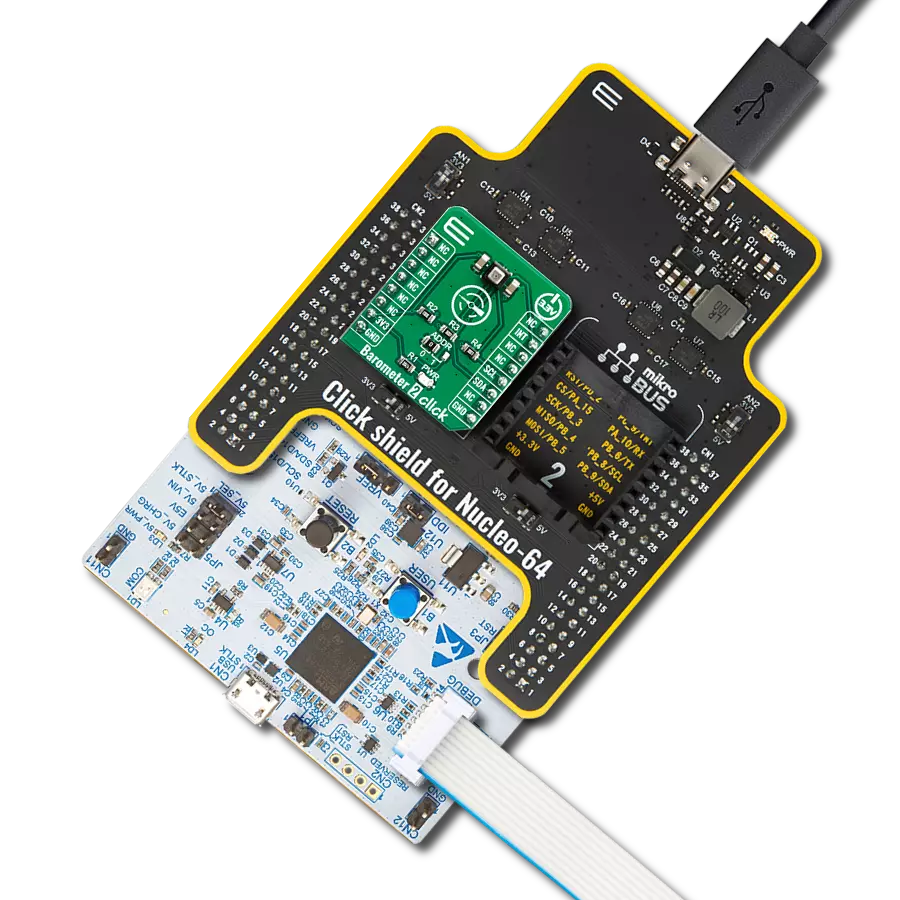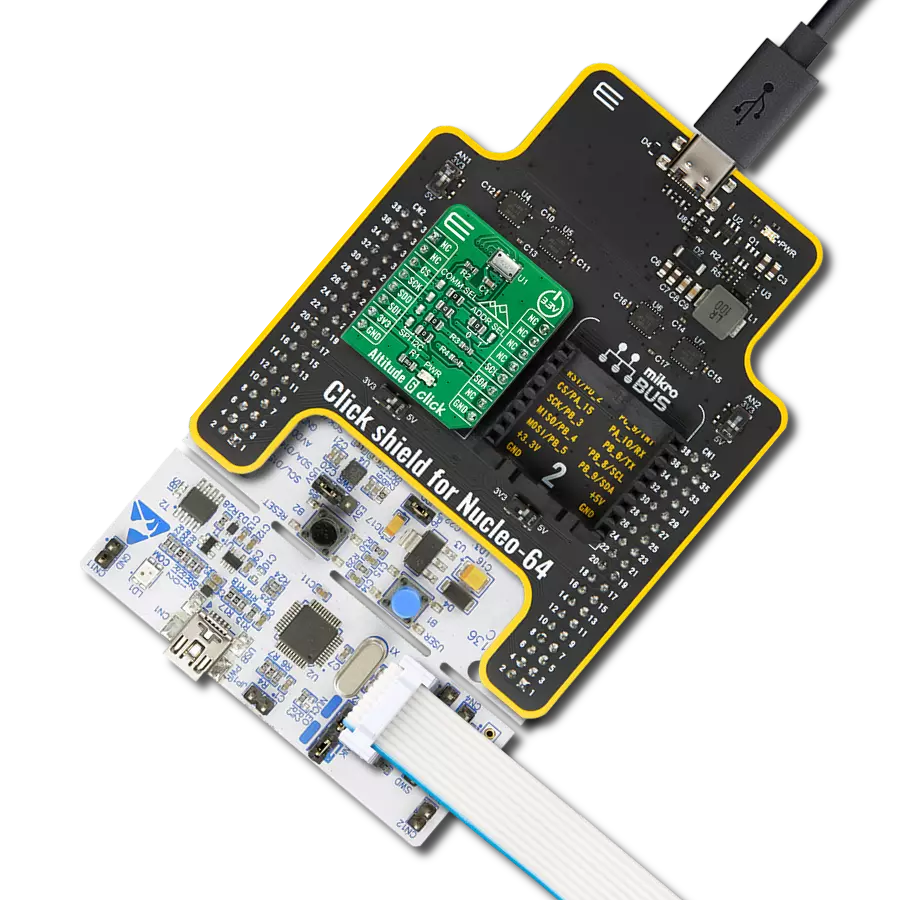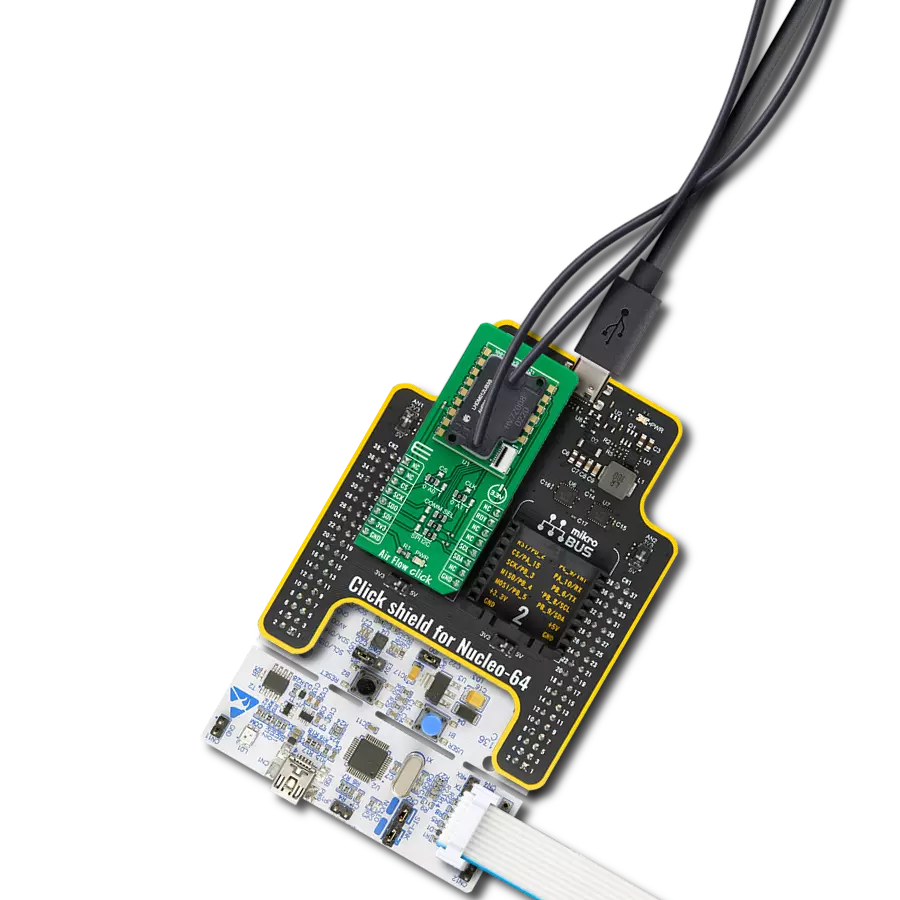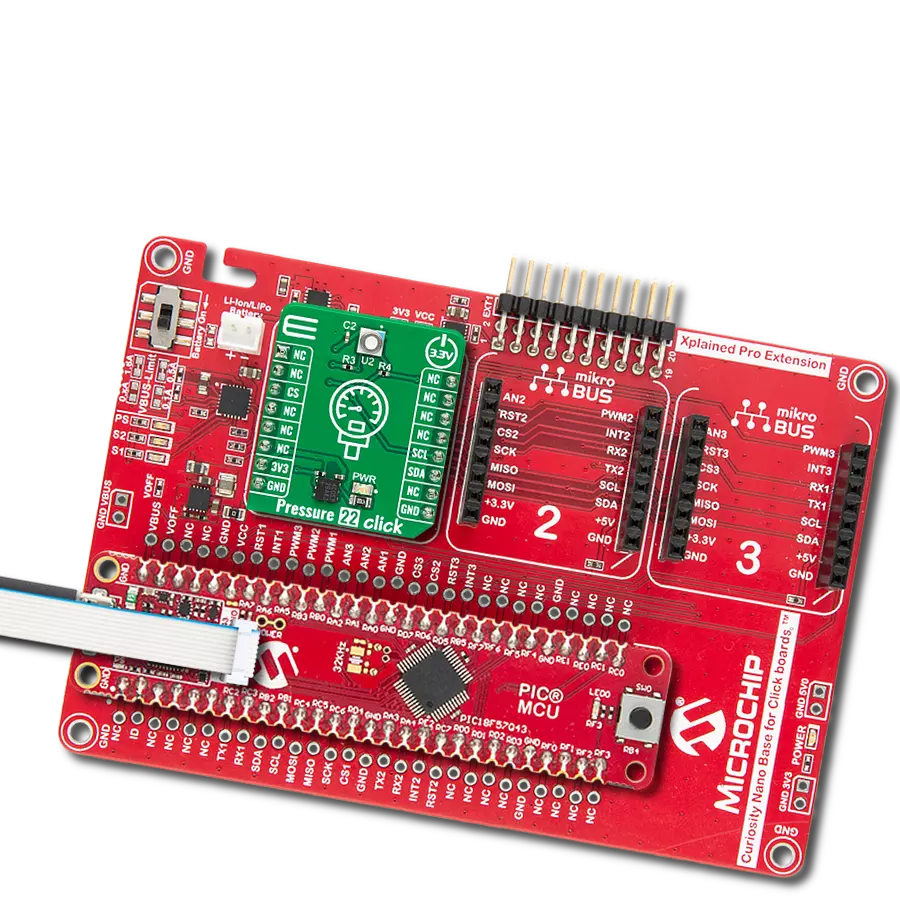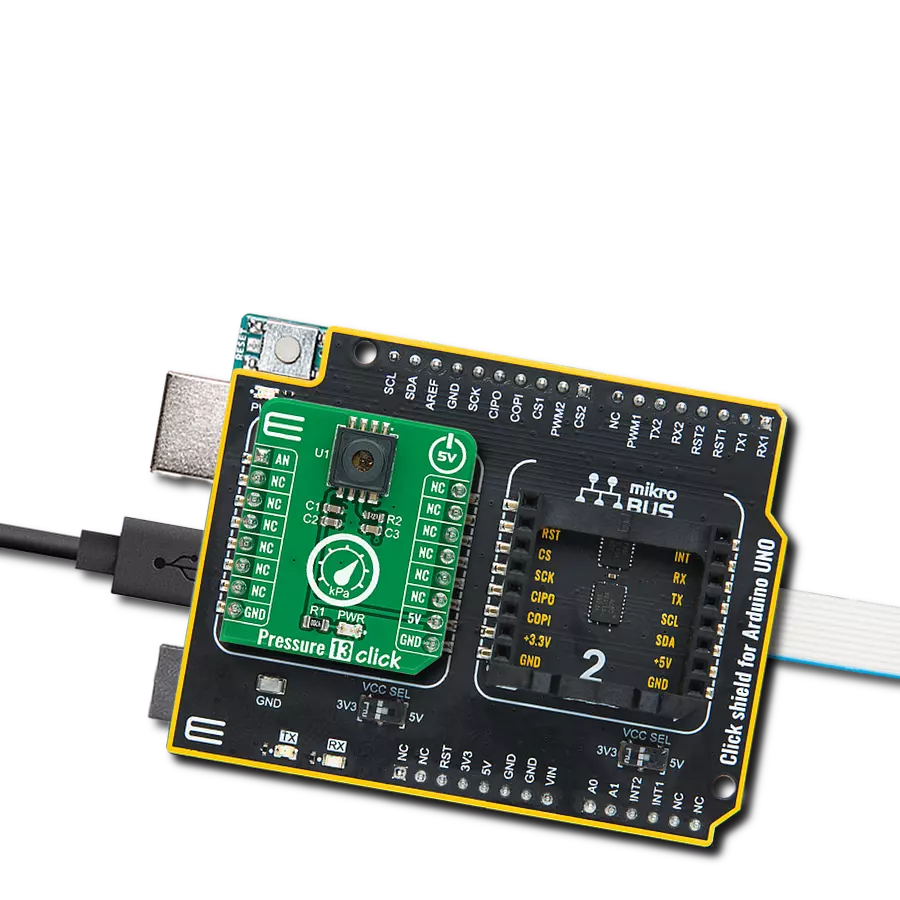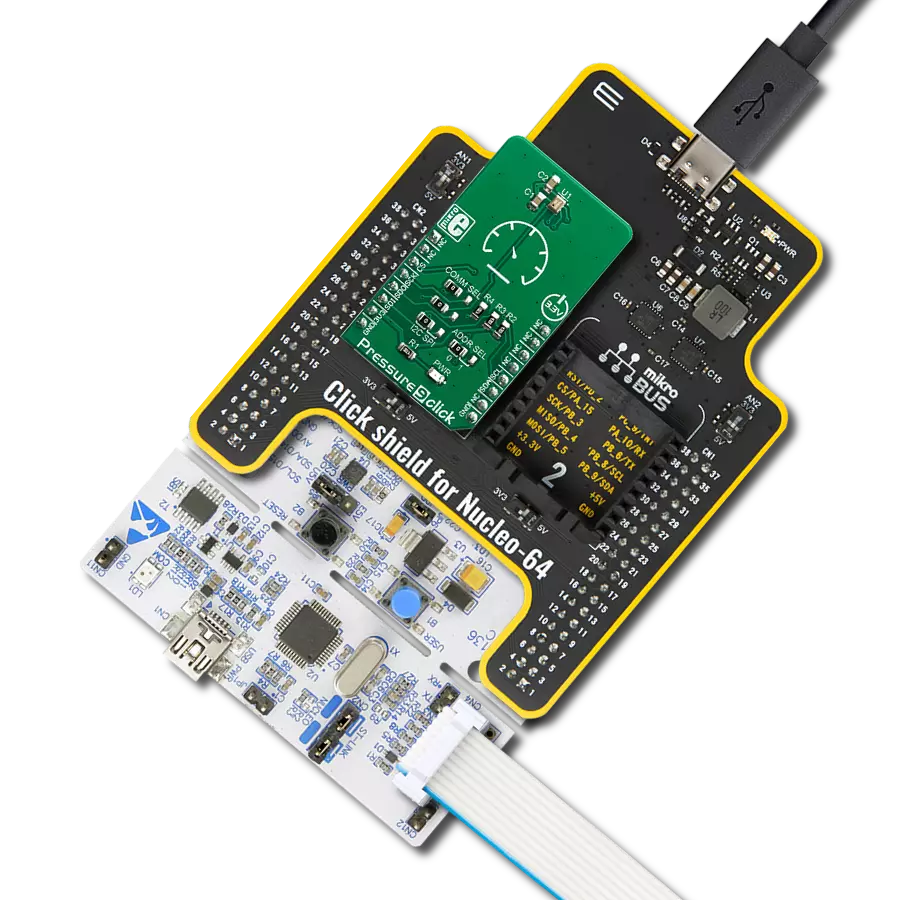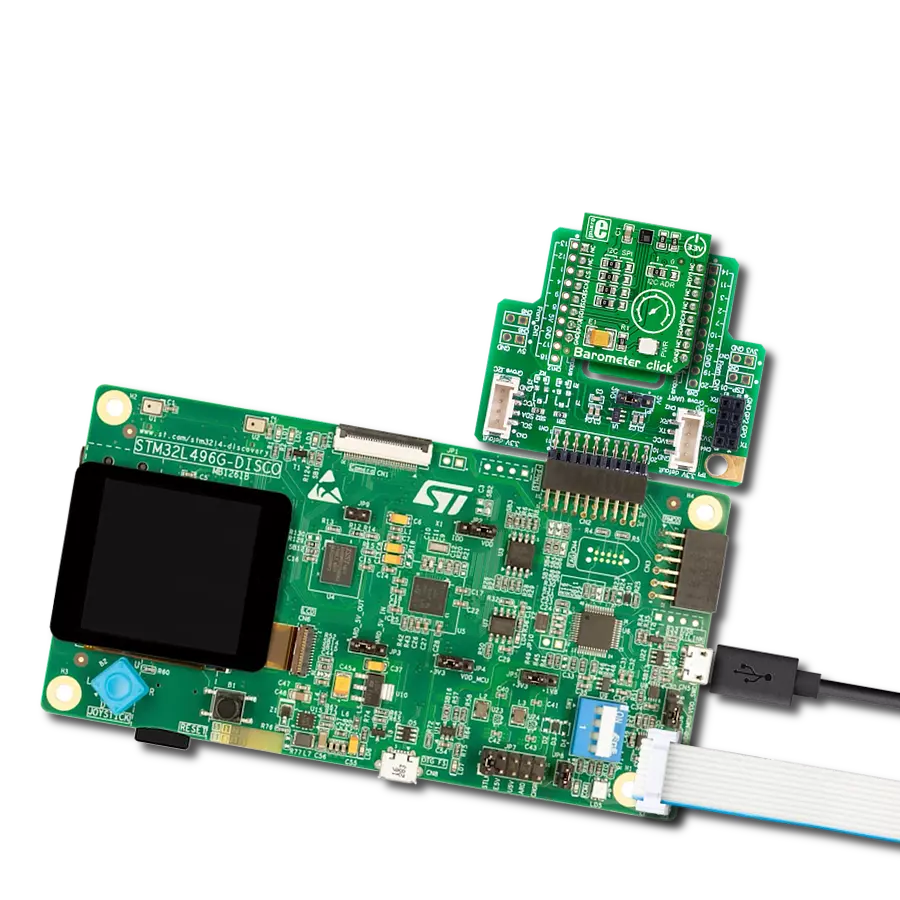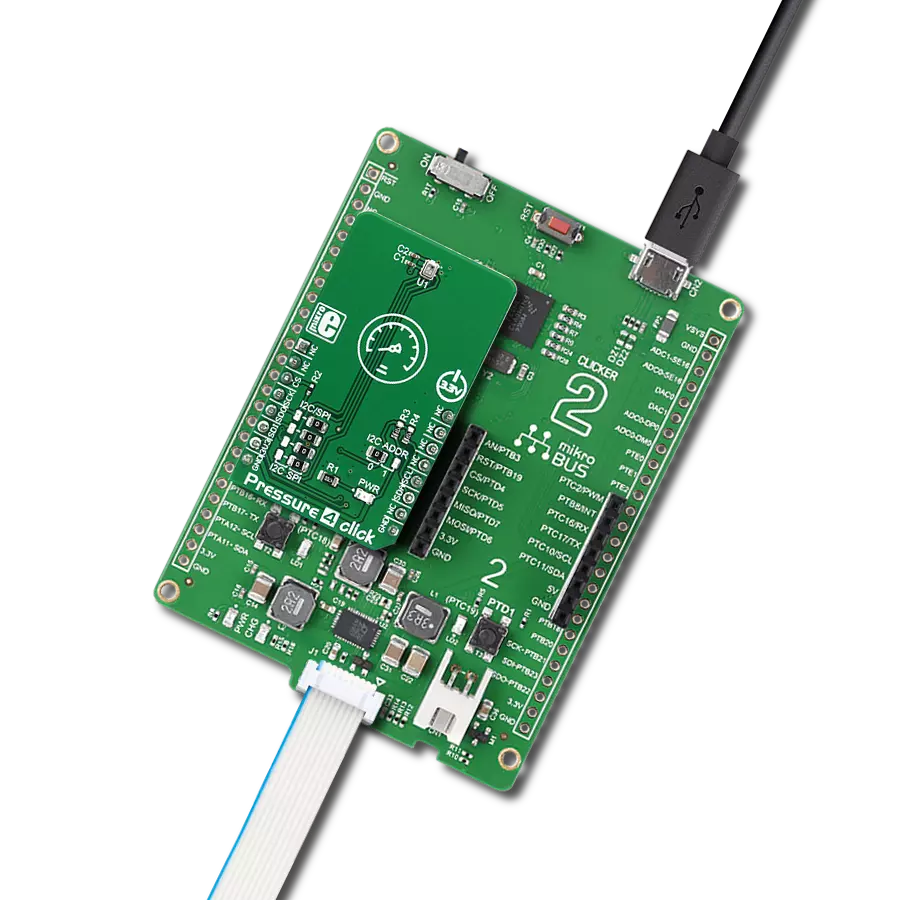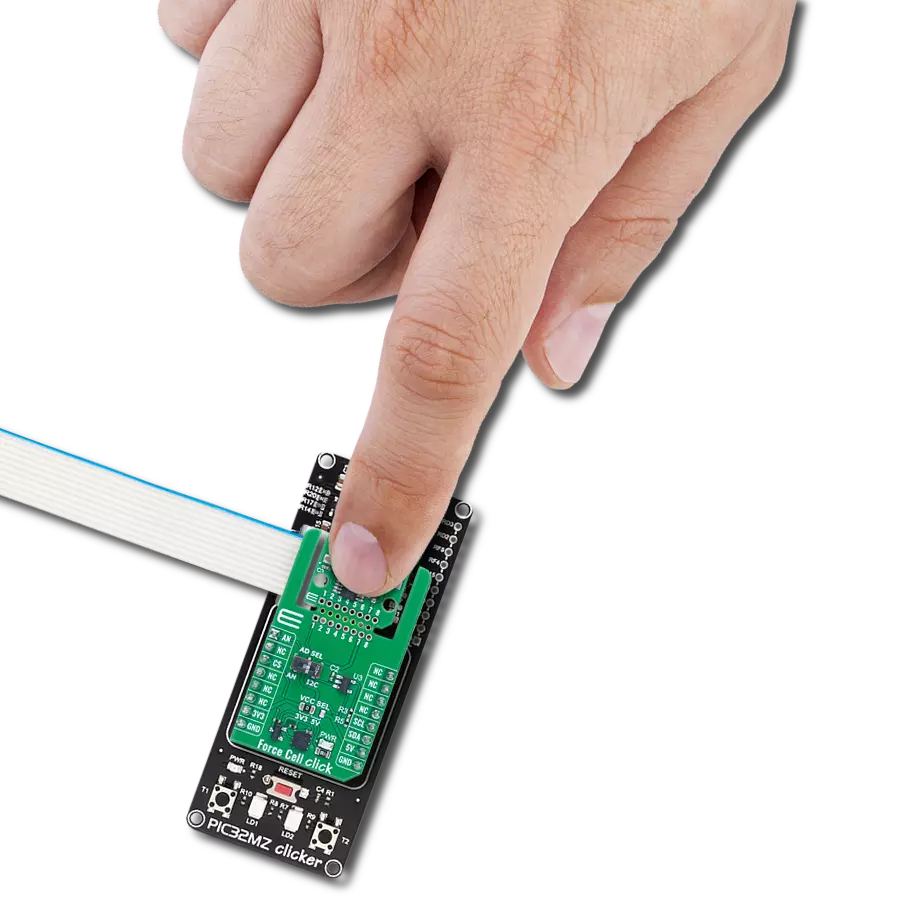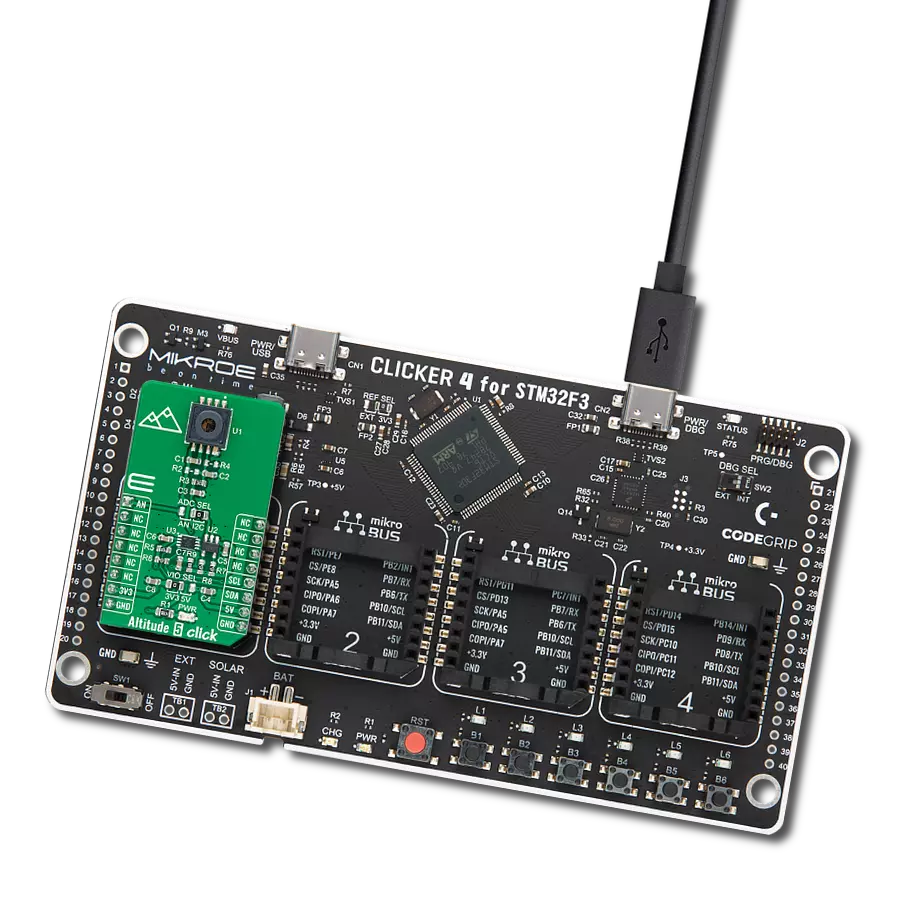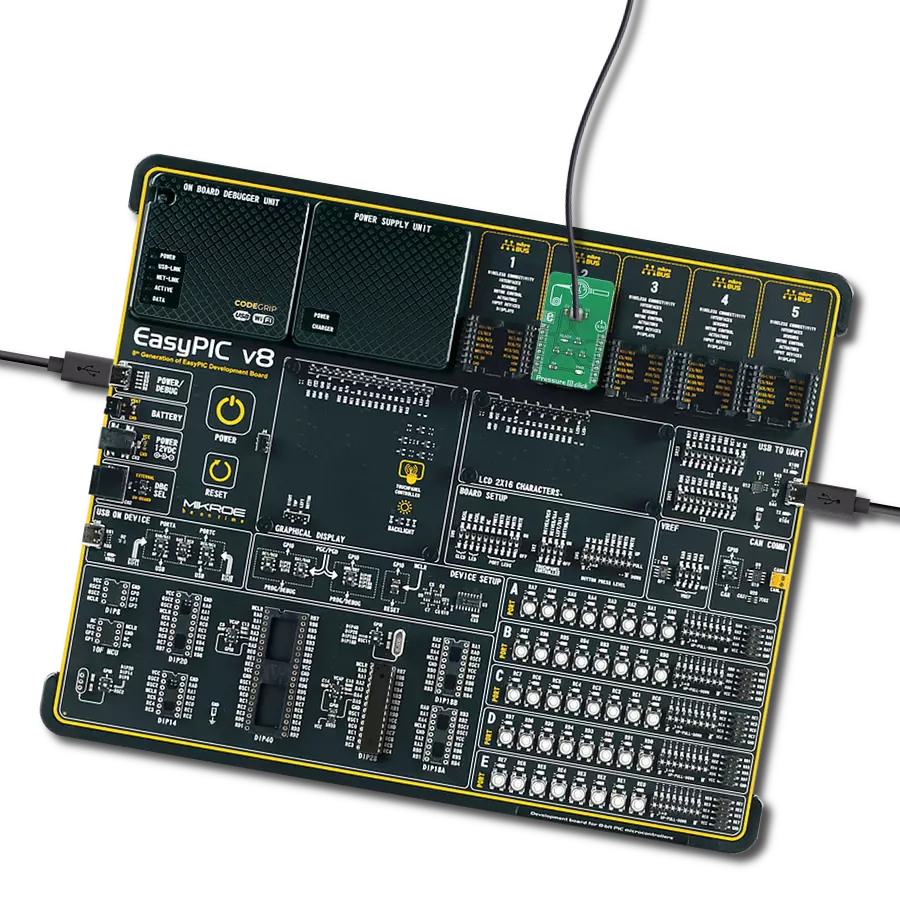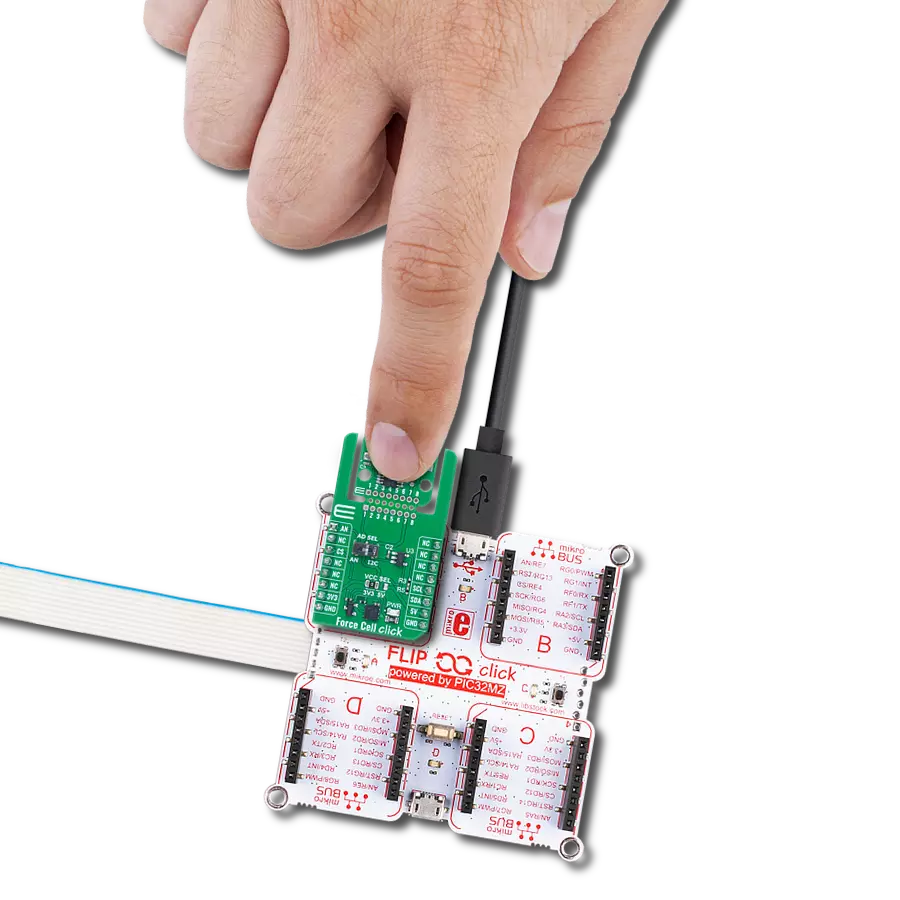Our altimeters are precision instruments crafted to provide reliable height data for a wide range of purposes
A
A
Hardware Overview
How does it work?
Altitude 6 Click is based on the MS5611-01BA03-50, a high-resolution barometric pressure sensor optimized for altimeter applications with an altitude resolution of 10 cm from TE Connectivity. The MS5611-01BA03-50 consists of a piezo-resistive sensor with an integrated signal conditioning circuit that can measure pressure from 10 mbar up to 1.2bar with an accuracy of 1.5 mbar over a wide operating temperature range at the lowest power consumption. The high accuracy and stability of pressure and temperature signals make it suitable for height sensing in medical and consumer applications, mobile altimeter or barometer systems, and many more. The MS5611-01BA03-50
also has ultra-low-power 24-bit ΔΣ ADC, internal factory-calibrated coefficients, and a high linearity pressure sensor. Its primary function is to convert the uncompensated analog output voltage from the piezo-resistive pressure sensor to a 24-bit digital value and provide a 24-bit digital value for the sensor's temperature, which allows the implementation of an altimeter function without any additional sensor. Altitude 6 Click allows the use of both I2C and SPI interfaces with a maximum frequency of 20MHz. The selection can be made by positioning SMD jumpers labeled as COMM SEL in an appropriate position. Note that all the jumpers' positions must be on the same side,
or the Click board™ may become unresponsive. While the I2C interface is selected, the MS5611-01BA03 allows choosing the least significant bit (LSB) of its I2C slave address using the SMD jumper labeled ADDR SEL to an appropriate position marked as 0 and 1. This Click board™ can be operated only with a 3.3V logic voltage level. The board must perform appropriate logic voltage level conversion before using MCUs with different logic levels. Also, it comes equipped with a library containing functions and an example code that can be used as a reference for further development.
Features overview
Development board
Arduino Mega 2560 is a robust microcontroller platform built around the ATmega 2560 chip. It has extensive capabilities and boasts 54 digital input/output pins, including 15 PWM outputs, 16 analog inputs, and 4 UARTs. With a 16MHz crystal
oscillator ensuring precise timing, it offers seamless connectivity via USB, a convenient power jack, an ICSP header, and a reset button. This all-inclusive board simplifies microcontroller projects; connect it to your computer via USB or power it up
using an AC-to-DC adapter or battery. Notably, the Mega 2560 maintains compatibility with a wide range of shields crafted for the Uno, Duemilanove, or Diecimila boards, ensuring versatility and ease of integration.
Microcontroller Overview
MCU Card / MCU
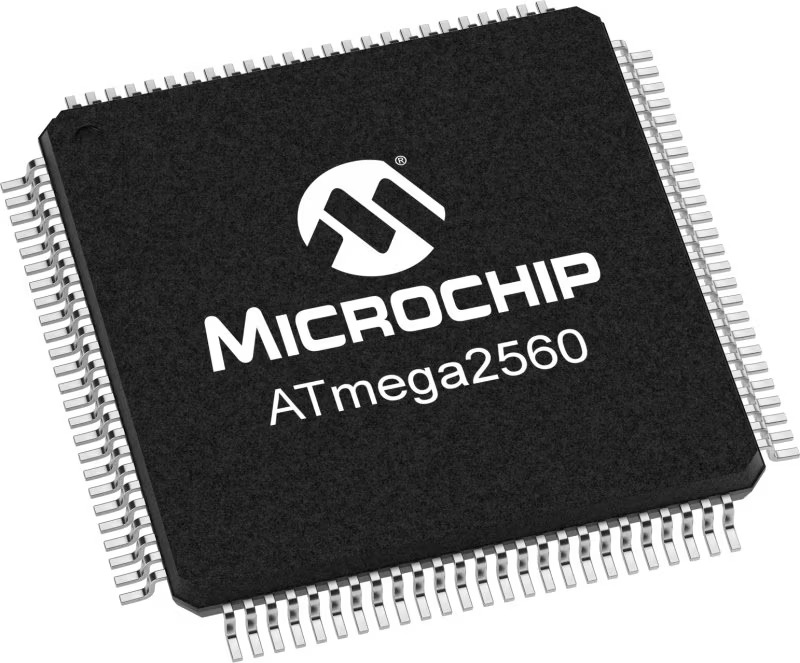
Architecture
AVR
MCU Memory (KB)
256
Silicon Vendor
Microchip
Pin count
100
RAM (Bytes)
8192
You complete me!
Accessories
Click Shield for Arduino Mega comes equipped with four mikroBUS™ sockets, with two in the form of a Shuttle connector, allowing all the Click board™ devices to be interfaced with the Arduino Mega board with no effort. Featuring an AVR 8-bit microcontroller with advanced RISC architecture, 54 digital I/O pins, and Arduino™ compatibility, the Arduino Mega board offers limitless possibilities for prototyping and creating diverse applications. This board is controlled and powered conveniently through a USB connection to program and debug the Arduino Mega board efficiently out of the box, with an additional USB cable connected to the USB B port on the board. Simplify your project development with the integrated ATmega16U2 programmer and unleash creativity using the extensive I/O options and expansion capabilities. There are eight switches, which you can use as inputs, and eight LEDs, which can be used as outputs of the MEGA2560. In addition, the shield features the MCP1501, a high-precision buffered voltage reference from Microchip. This reference is selected by default over the EXT REF jumper at the bottom of the board. You can choose an external one, as you would usually do with an Arduino Mega board. There is also a GND hook for testing purposes. Four additional LEDs are PWR, LED (standard pin D13), RX, and TX LEDs connected to UART1 (mikroBUS™ 1 socket). This Click Shield also has several switches that perform functions such as selecting the logic levels of analog signals on mikroBUS™ sockets and selecting logic voltage levels of the mikroBUS™ sockets themselves. Besides, the user is offered the possibility of using any Click board™ with the help of existing bidirectional level-shifting voltage translators, regardless of whether the Click board™ operates at a 3.3V or 5V logic voltage level. Once you connect the Arduino Mega board with Click Shield for Arduino Mega, you can access hundreds of Click boards™, working with 3.3V or 5V logic voltage levels.
Used MCU Pins
mikroBUS™ mapper
Take a closer look
Click board™ Schematic

Step by step
Project assembly
Software Support
Library Description
This library contains API for Altitude 6 Click driver.
Key functions:
altitude6_get_data- Altitude 6 get data functionaltitude6_get_raw_data- Altitude 6 get raw data functionaltitude6_get_calibration_data- Altitude 6 get calibration data function
Open Source
Code example
The complete application code and a ready-to-use project are available through the NECTO Studio Package Manager for direct installation in the NECTO Studio. The application code can also be found on the MIKROE GitHub account.
/*!
* @file main.c
* @brief Altitude6 Click example
*
* # Description
* This library contains API for Altitude 6 Click driver.
* The demo application reads and calculate
* temperature, pressure and altitude data.
*
* The demo application is composed of two sections :
*
* ## Application Init
* Initializes I2C or SPI driver and log UART.
* After driver initialization the app set
* driver interface setup and default settings.
*
* ## Application Task
* This is an example that demonstrates the use of the Altitude 6 Click board™.
* In this example, display the Altitude ( m ),
* Pressure ( mBar ) and Temperature ( degree Celsius ) data.
* Results are being sent to the Usart Terminal where you can track their changes.
*
* @author Nenad Filipovic
*
*/
#include "board.h"
#include "log.h"
#include "altitude6.h"
static altitude6_t altitude6;
static log_t logger;
void application_init ( void )
{
log_cfg_t log_cfg; /**< Logger config object. */
altitude6_cfg_t altitude6_cfg; /**< Click config object. */
/**
* Logger initialization.
* Default baud rate: 115200
* Default log level: LOG_LEVEL_DEBUG
* @note If USB_UART_RX and USB_UART_TX
* are defined as HAL_PIN_NC, you will
* need to define them manually for log to work.
* See @b LOG_MAP_USB_UART macro definition for detailed explanation.
*/
LOG_MAP_USB_UART( log_cfg );
log_init( &logger, &log_cfg );
log_info( &logger, " Application Init " );
// Click initialization.
altitude6_cfg_setup( &altitude6_cfg );
altitude6_drv_interface_selection( &altitude6_cfg, ALTITUDE6_DRV_SEL_I2C );
ALTITUDE6_MAP_MIKROBUS( altitude6_cfg, MIKROBUS_1 );
err_t init_flag = altitude6_init( &altitude6, &altitude6_cfg );
if ( ( I2C_MASTER_ERROR == init_flag ) || ( SPI_MASTER_ERROR == init_flag ) )
{
log_error( &logger, " Communication init." );
for ( ; ; );
}
if ( ALTITUDE6_ERROR == altitude6_default_cfg ( &altitude6 ) )
{
log_error( &logger, " Default configuration." );
for ( ; ; );
}
log_info( &logger, " Application Task " );
log_printf( &logger, "----------------------------\r\n" );
Delay_ms ( 100 );
}
void application_task ( void )
{
static float temperature;
static float pressure;
static float altitude;
if ( altitude6_get_data( &altitude6, &temperature, &pressure, &altitude ) == ALTITUDE6_OK )
{
log_printf( &logger, " Altitude : %.2f m \r\n", altitude );
log_printf( &logger, " Pressure : %.2f mbar \r\n", pressure );
log_printf( &logger, " Temperature : %.2f C \r\n", temperature );
log_printf( &logger, "----------------------------\r\n" );
}
Delay_ms ( 1000 );
}
int main ( void )
{
/* Do not remove this line or clock might not be set correctly. */
#ifdef PREINIT_SUPPORTED
preinit();
#endif
application_init( );
for ( ; ; )
{
application_task( );
}
return 0;
}
// ------------------------------------------------------------------------ END
Additional Support
Resources
Category:Pressure





















